The Appealing Grundig TK 18 Tape Recorder
The must-have technology for an aspiring technophile in the early 1960s was a reel to reel tape recorder, and one of the prime manufacturers of such devices was a German company called Grundig. This article looks at one of their offerings from 1963, the Grundig TK 18 reel to reel tape recorder.
My Grundig TK 18 Tape Recorder
I bought this Grundig TK 18 Tape Recorder from eBay for about £26 including postage, which is more than I would spend if I was buying a vintage radio, but there were several reasons for paying that much. For a start the unit looked incredibly clean and tidy in the photos the seller posted on eBay, and another reason is that being more complex technology, Tape Recorders tend to cost more than radios or record players.
The biggest reason, however, is that my Dad had a Grundig tape recorder in the 1960s, and I guess I wanted to relive a bit of my past.
The seller described the recorder as not working – ‘Powers up, rewind and fast-forward working but no sound on normal play’. That sounded like something I’d have fun fixing, so I paid for it and waited for it to be delivered. Fortunately, there was a tape included in the sale because, although I had a tape recorder sometime in the 1970s (a very nice Tandberg unit with a smoked glass cover) any reels of tape I owned then have long since gone.
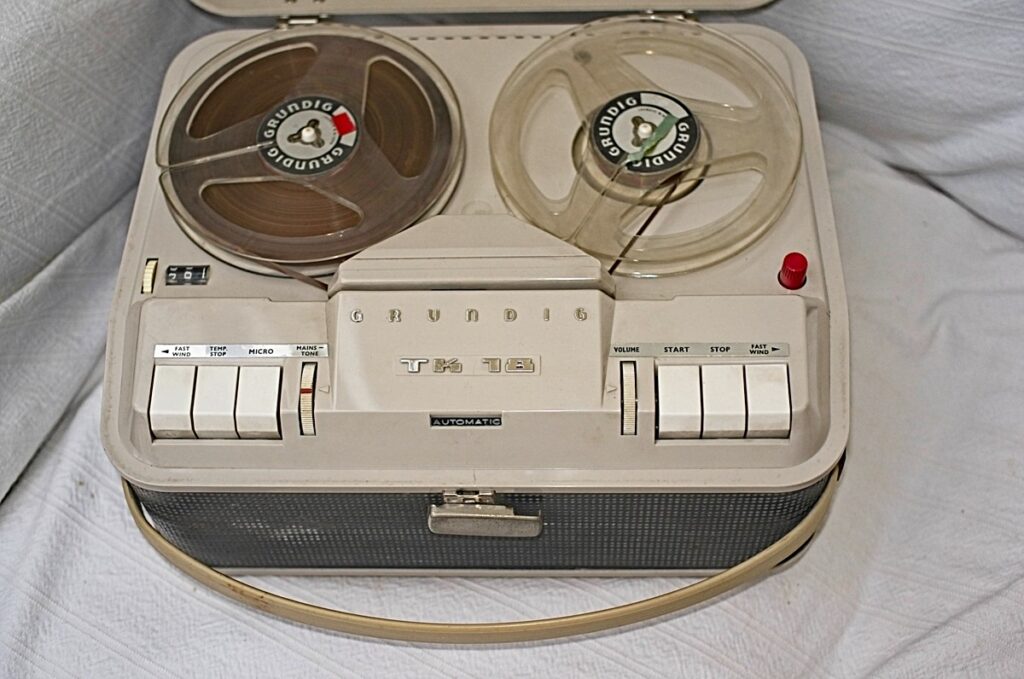
The unit turned up a few days after I completed the sale, and the impression I had gained from the seller’s photos turned out to be pretty accurate. It is a clean and tidy unit (in the sense that there is no major damage – it was a bit grubby and needed a clean) and when I plugged it into the mains and tried it out1 the description was pretty accurate. The rewind worked and the fast-forward sort of worked, but when the play key was pressed, the tape wouldn’t budge.
Fixing the tape transport
It looked like I needed to get into the recorder to see what was wrong, and the most logical way I could see was to remove the four obvious screws on the plastic top panel. I took these out, noting that the one on the left hand bottom edge was a different length than the one on the right-hand bottom, but once all the screws were out, I couldn’t actually lift the cover away. It seemed to be free and could be lifted, but I couldn’t remove it completely.
After a lot of messing about, I finally Googled it and found that the sets of three keys on either side of the recorder need to be pressed down together enough to allow the top panel to be lifted free. Once you know that it becomes easy to remove, but without that knowledge you are stuck.
With the top cover off, the reason the tape wouldn’t move became obvious. The TK 18 uses three rubber drive belts, and two of them were laying in the tape transport in a perished mess. The two belts seemed to be used to drive the flywheel on the capstan and the forward tape transport.
Diversion – how a tape recorder works
I’m going to diverge a bit from the Grundig TK 18 for a moment and just describe how a tape recorder transport works. If you are familiar with this, just skip this section.
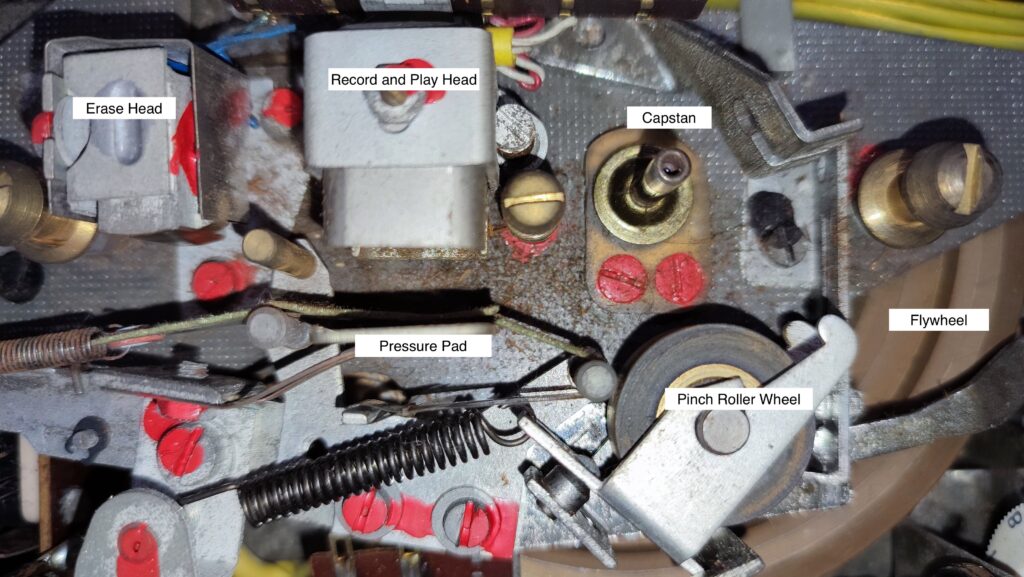
The photo here shows the tape heads and capstan from the TK 18. The tape would normally fall in the slot across the centre of the picture, aligning with the two guide posts at the ends.
When the play button is pressed, the assembly which holds the Pressure Pad and the Pinch Roller wheel is moved forward so the tape is caught between the capstan and the Pinch Wheel. It is in contact with the two heads (the erase head and the record/play head) and kept held tightly against them by the pressure pad.
The way sound is recorded is by small magnetic changes which are formed on the tape as it passes in front of the record head. In effect, the record head is an electromagnet that magnetises the tape in sympathy with the sound being fed into the recorder.
In order for the sound to be accurately recorded, the speed of the tape as it passes in front of the head has to be very accurately controlled. This is the job of the capstan and pinch roller which pulls the tape through at a uniform speed, and the uniformity of the speed is controlled by the large mass of the flywheel which is attached to the capstan. On the photo, you can see the flywheel underneath the metal that supports the heads. Because the flywheel has a high mass, it smooths out any small fluctuations in the speed.
The important bit is that the tape is not pulled through by the reel that collects the tape – that is actually driven by a clutch (actually a soft felt pad that transmits the motion) and only makes sure the tape is gathered onto the take-up reel.
Back to the TK 18
So, I was faced with a tape deck that wouldn’t play and a couple of broken drive belts. The two belts were the one used to transmit drive to the capstan from the tape recorder motor, and the one that drives the take-up spool. The third belt is used to drive the tape counter and when I looked at it that seemed to be on it’s last legs as well, so really I needed to buy a complete set of belts for the TK 18.
I had a look on eBay, and it’s possible to buy a belt set for this machine for about £11, but I didn’t want to do that only to find the recorder didn’t work anyway, so made sure the rest of the recorder was working by switching it on, putting it into play, turning the volume level up and then pulling the tape through the tape transport. When I did this I could hear the recorder start to play, so I thought there was a good chance it would be OK.

Even so, rather than initially buying a set of belts, I firstly made up some belts using some Urethane Belting that I’d purchased to make drive belts for vintage projectors. This belting is supplied in a long length, and you weld it together by cutting it to the correct length and heating both ends until they are soft and then pushing them together. As I say, I bought it for projector belts, but I thought I’d see how it performed on the tape deck.
Using the original belt as a template for the correct length, I made up three new belts and then had to fit them to the recorder. The tape counter belt was easy because it just slips over the top of the feed reel, but the other two involved removing the platform that the tape heads are fitted on, so I could push the new belts over the flywheel where they connect to.
With the belts fitted there was partial success because the tape recorder started to play, but there was some serious wow and flutter which I thought was probably caused by the join in the belt not being perfectly flat((I think I need to make up some sort of jig, so I can heat the end of the belt whilst it’s in a constricting tube, so the joined ends remain circular)). Also, after I’d fitted the new belts, I found that the fast rewind no longer worked, and the play function also didn’t work well at the start of the tape because the feed reel wouldn’t turn properly.
A bit of investigation led me to find that the belt I’d made for the tape counter was a bit too tight, and it was stopping the rewind action by pulling the feed reel away from the direct drive motor that it needs to contact to work. When I removed the counter drive belt, both the fast rewind and the play started to work correctly and the wow and flutter didn’t seem so pronounced either.
I’m fairly sure that if I buy a set of proper belts, the unit will be fine – if I do that, I’ll write a post detailing how to fit them.
The other actions that the recorder needs are a proper clean both on the outside, but also on the inside around the various mechanisms that are used to get the recorder functions working, and particularly through the tape path which has lots of muck and grime.
Pictures of the Grundig TK 18
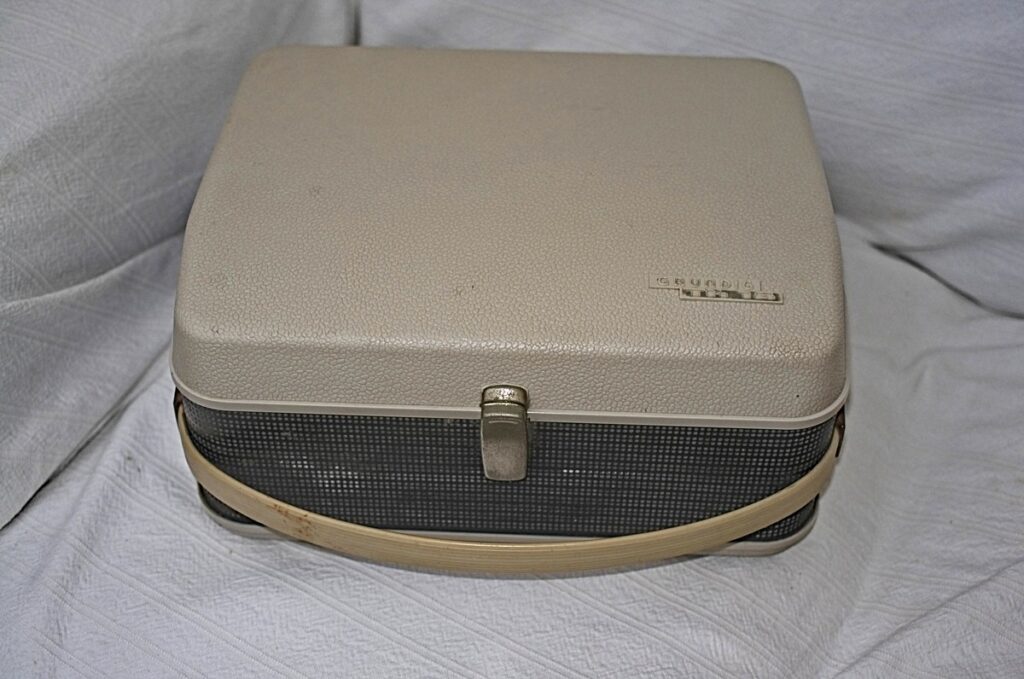

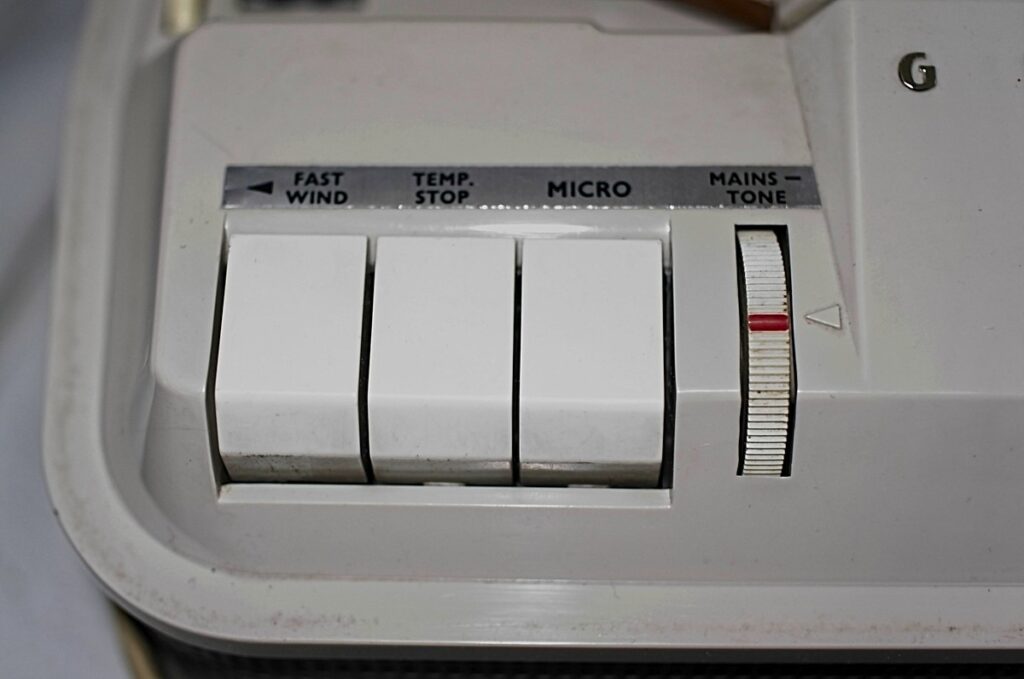
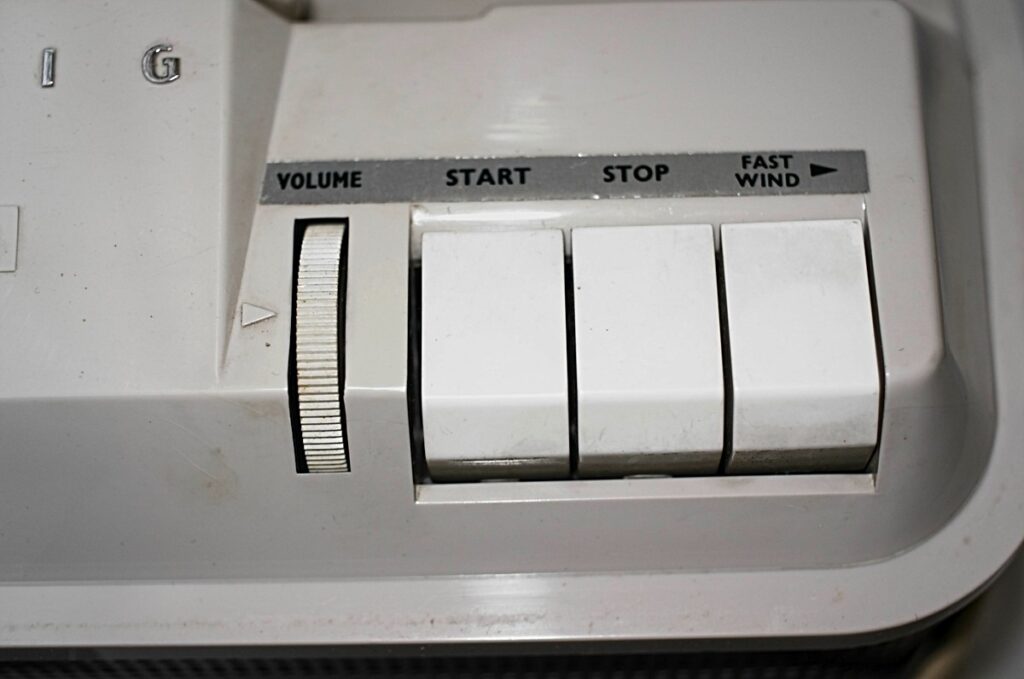
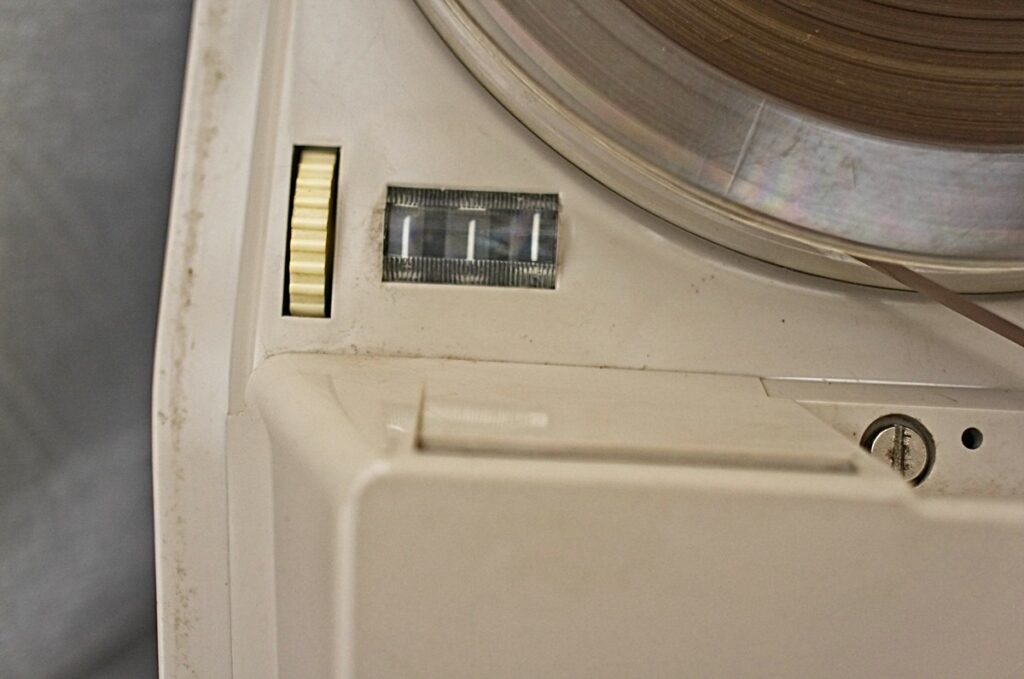
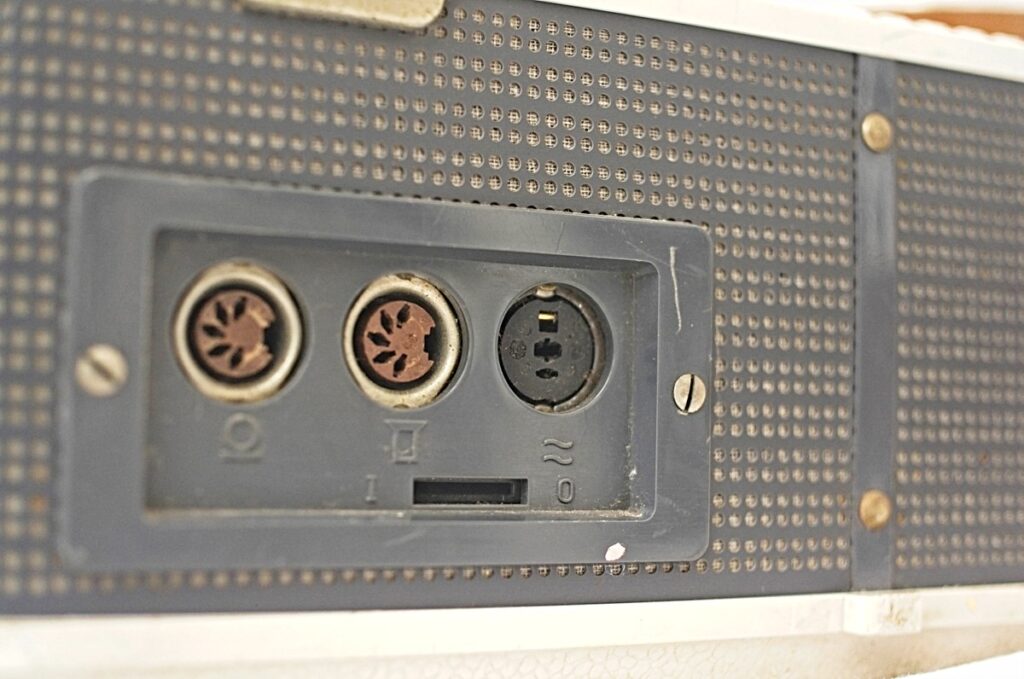
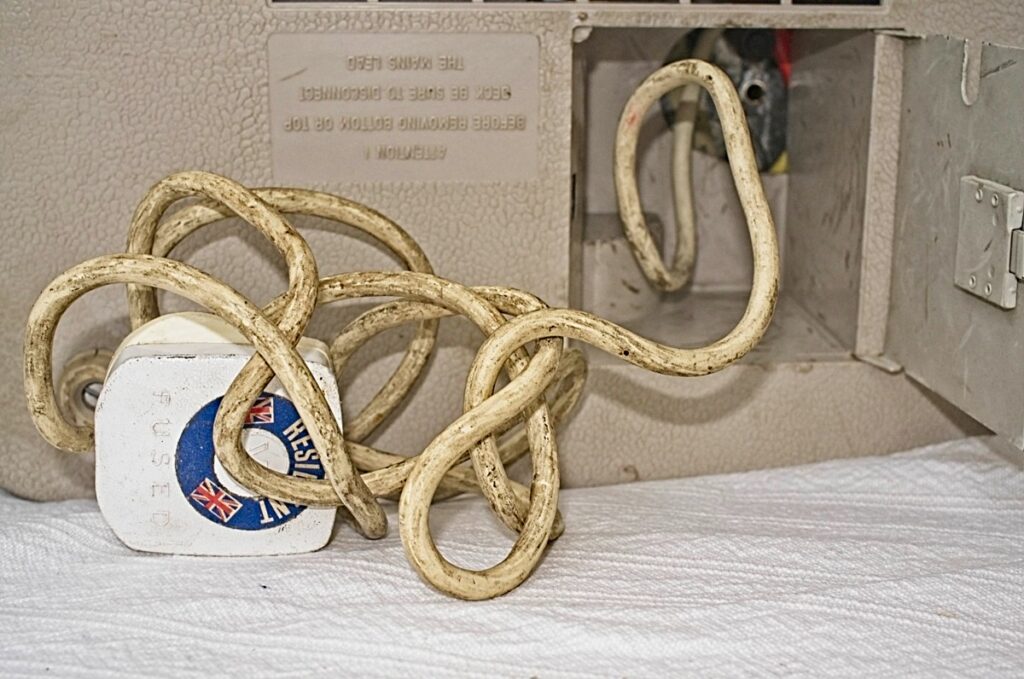
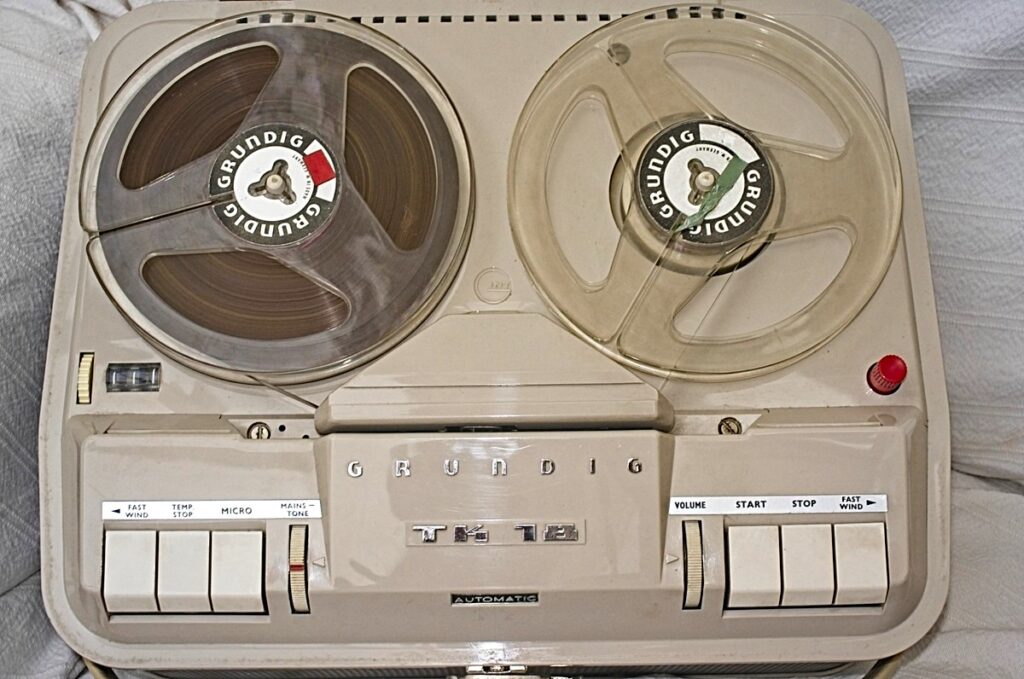

Grundig TK 18 Description
The Grundig TK 18 is a single speed, mono tape recorder that was made in about 1963. It takes reels of tape up to 5 3/4 inch in size and records at a tape speed of 3 3/4 inches per second, which was the standard speed for entry level tape recorders((Better spec machines would record at 7 1/2 inches per second and machines that recorded mostly speech would record at 1 7/8th. Many machines were made that could switch between the different speeds)).
The recorder has inputs for microphone, and line (i.e. radio tuner or record deck) and an output socket to drive an external speaker.
The main feature of the TK 18 is the fact that it’s an automatic recorder. Instead of having to set a recording level when making a recording, the TK 18 automatically adjusts the level to suit the set input level. Now I remember having a cassette recorder in the 1970s that had the same ‘automatic recording level’ and I found it to be completely useless. Every time the input level went up because, for example, there was a loud passage of music, you could hear the recorder suddenly drop the level to compensate.
According to an article I read on the TK 18, there is supposedly a reasonable time delay in the automatic recording level loop to avoid such problems – once I get the recorder running properly, I may try to see if this is the case.
To operate the unit, a tape is placed on the left-hand reel holder, threaded through the slot where the tape heads are concealed and then threaded onto an empty reel on the right-hand reel holder. To play a recorded tape, the ‘Play’ key is pressed, and the tape will start moving from the full reel to the empty reel and play what ever is recorded on the tape.
There is a ‘Temp Stop’ key, which pauses the playback without fully releasing the tape from the tape drive. I suspect this is more useful in record mode, when the machine can be set up ready to record and this button released at the appropriate time.
To record, there is a red button above the right-hand set of keys that is turned clockwise and pushed down to place the machine if record mode. Then, when the ‘Play’ key is pressed, the recorder will start recording whatever is fed into the input, or spoken into the microphone if Mic input is selected. When the recording is stopped with the ‘Stop’ key, the red button will pop up, meaning you won’t accidentally record or erase when you meant to play.
The other controls are buttons to Fast forward and Fast rewind the tape, and there is a tape counter that records the amount of tape that’s been recorded or played. I don’t think the counter is actually calibrated in feet of tape – it’s just a relative measure.
Reel to reel tape recorders work in the same way that cassette recorders worked – the audio is recorded on just the top half of the tape, so once the reel is completely recorded it can be turned over and the process started again to record on the other half. At the speed the Grundig recorded at, this means a full reel of tape would give about 35 minutes playing time.
Video of Tape recorder
The video below is a short clip showing the tape recorder after I’d fitted the new belts and removed the tape counter belt.
Grundig TK 18 Specification
- Grundig TK 18 Tape recorder
- Made in about 1963
- Takes 5 3/4 reels of 1/4 inch magnetic tape, giving about 35 min playing time per side
- Tape counter to show progress through a tape
- Recording button pops-up after recording session to stop accidental recording
- Recording / Playback speed 3 3/4 inches per second
- Frequency Response 40Hz to 13 kHz
- 5 1/2 by 4 1/2 internal speaker
- 240v mains supply
- I know it’s not a good idea to plug old technology in to the mains without some initial testing but in this case the seller had already tried it on the mains [↩]
Discover more from Everything Vintage
Subscribe to get the latest posts sent to your email.

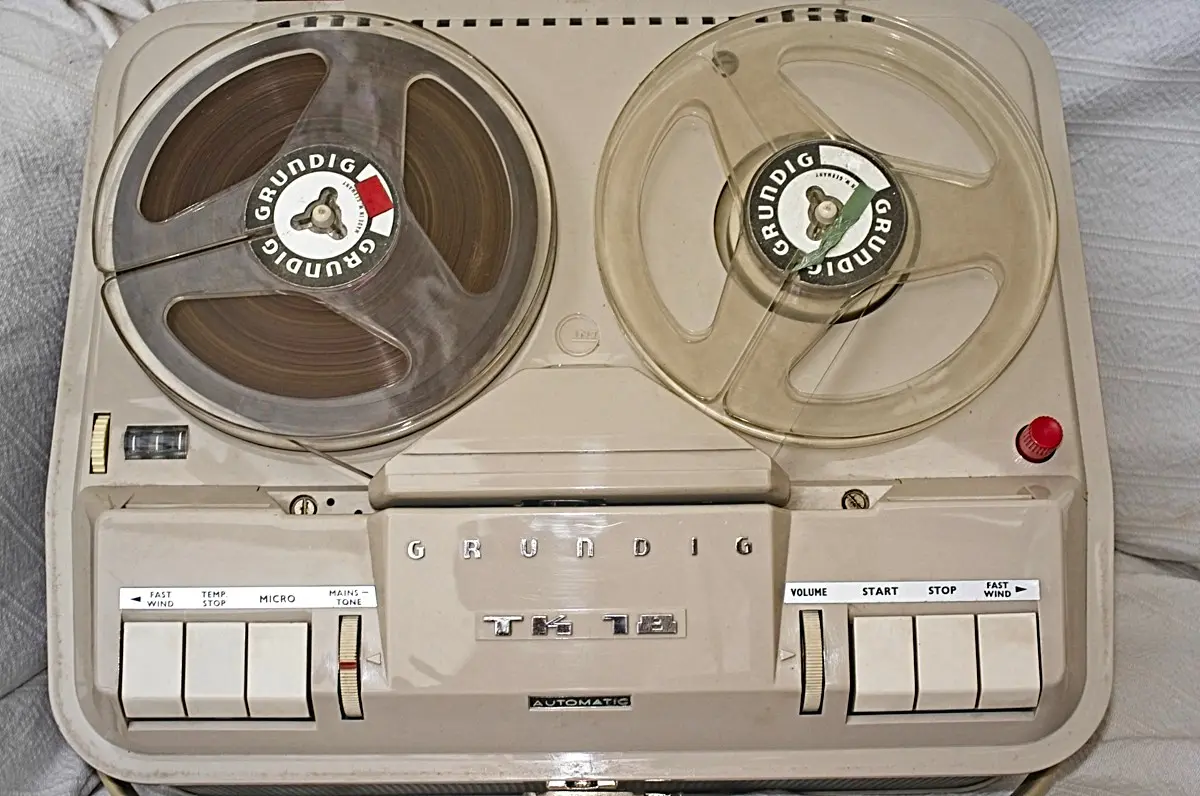
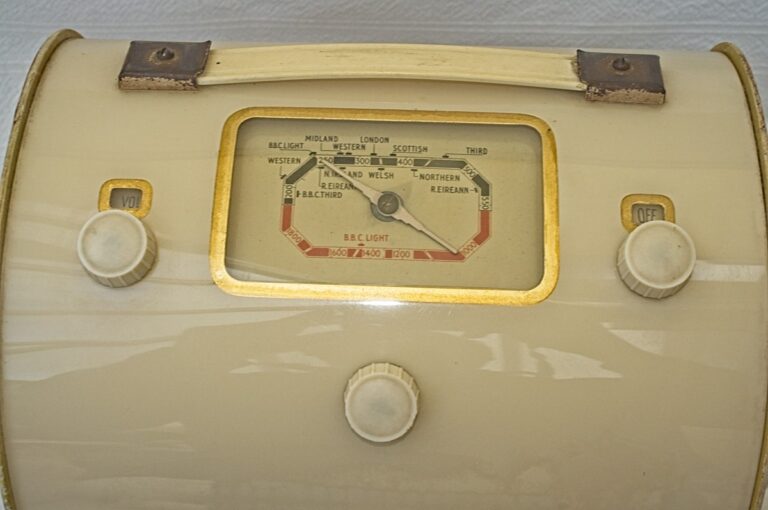

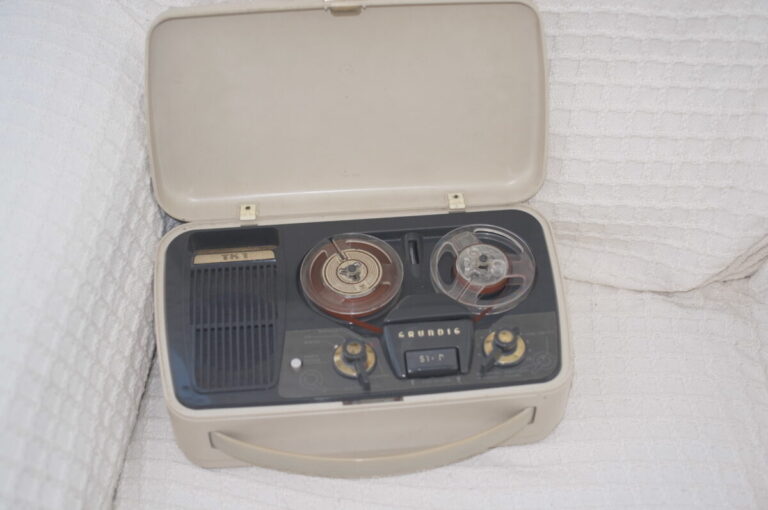
Hi, I read your article on the TK 18 with great interest. I have a TK14 (in the loft) which I have had since I was about 11 years old (about 1960) and it was my pride and joy. It looks identical to yours (except for the number TK14). I have been thinking for a while to get it down and see if I can get it working again. The last time I tried it several years ago the belts were slipping. Do you know if you can still get the recording heads for these machines?